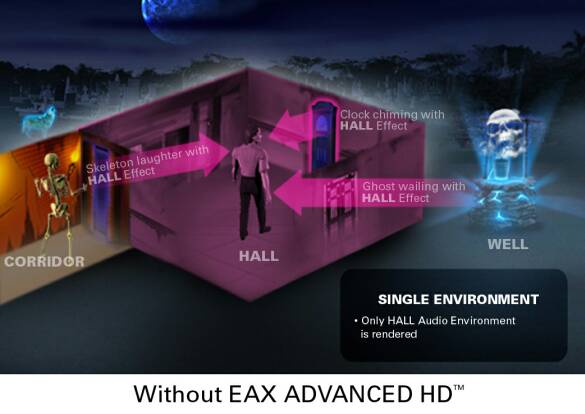Big Sound, Low Price: Creative Audigy
Using The Card For Games
Creative Labs is taking advantage of the launch of its new soundcards and their power to offer new sound effects for games. But, just as with 3D images, for 3D sound it is necessary for the game to be programmed specifically. Sound is to some extent undergoing a parallel evolution to that of the image, but with a certain delay. Today's games mostly have 3D sound, but content themselves with positioning the sounds in space. It's a little like sticking 3D images on bare walls. However, it is already possible to use more sophisticated effects such as obstruction, for example. When 3D sound made its debut in games, Creative had already set up its EAX standard without any difficulty.
Before the arrival of the Audigy car, they were up to version 2. What's more, Direct X began managing 3D sounds using Direct Sound 3D. Now the third possibility, the A3D, has disappeared, only Direct X and Creative remain. It might have been expected that the EAX would not have lasted the course and that only Direct Sound 3D would survive. But this was not the case. Today's games for the most part use Direct Sound 3D, but also support EAX, some in version 2.0. It has to be made clear that Creative has also made EAX accessible to other soundcard manufacturers. The new norm will be reserved for Audigy, at least for now. In a way, it's the EAX 3, renamed Advanced HD.
EAX Advanced HD
Up to now, 3D sound has limited itself mostly to positioning a sound in three dimensions (Direct Sound and EAX 1). In other words, when a monster lifts you up from behind, you really hear it behind you. With EAX 2, you also have occlusion and obstruction effects which take into account any barriers between you and the source of the noise: a wall, a curtain ... The sound environment becomes more realistic. This is how Creative outlines this era.
The Advanced HD goes a lot further. Firstly, it is now possible to have four distinct sound environments at once. This means you are able to hear multiple sounds that come at you from different sources. A monster roaring behind a wall will not sound the same to you as the cries of a young virgin being sacrificed at the same time on the altar you can see through the window. In the same way, it is possible to render the modifications made to a sound by its surroundings. A stone wall in a haunted manor doesn't reflect sound in the same way as a metal partition in a spaceship. It's also possible to filter the sound according to the environment, to restore an open-air sound to the ocean or a dull sound in a small room. Finally, there are morphing effects to make fluid sound transitions and reverb effects to imitate the resonance of closed spaces. The DSP works well with all these hardware functions. This is how Creative explains the interest of these new functions.
Get Tom's Hardware's best news and in-depth reviews, straight to your inbox.

